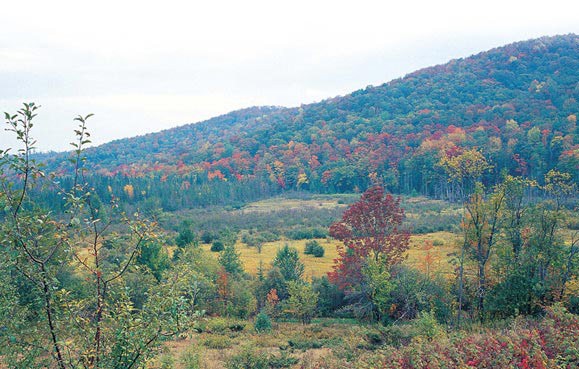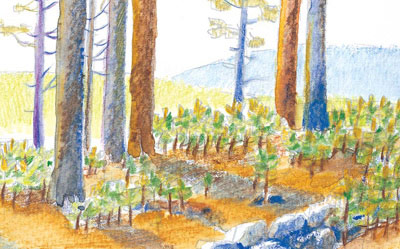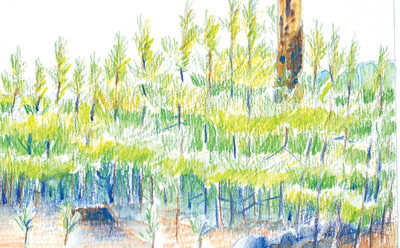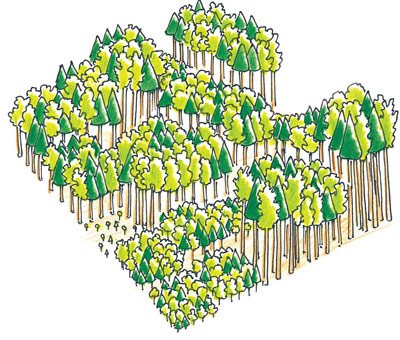
According to traditional forestry, there are two kinds of forests. Every forest you step into can be categorized as either even-aged or uneven-aged. But most foresters regularly come across woodlots that don’t neatly fit into either of those two pigeonholes, and they can be left scratching their heads over how to manage them.
When a forester creates a management plan for a forest, he or she will describe the conditions that currently exist, note what the forest owner would like to have happen over time, and delineate a plan for how to achieve those objectives. One of the first steps in devising the plan is dividing the forest into stands. Each stand is an area of forest within which the conditions are similar enough that it can be covered by a single description, statement of objectives, and plan of management activities.
That similarity will be expressed in terms of the site quality, what tree species are present, and the distribution of the trees in terms of age and size. That last parameter is at the heart of whether a stand is described as being even-aged or uneven-aged.
Even-aged Stands
The prototypical even-aged stand is a plantation. All the trees are planted at the same time and are, therefore, the same age. As the trees grow older, one or more thinnings may be performed to give the remaining trees more access to light, water, and nutrients and thus speed their growth.Useful wood may also be harvested during the thinnings, and some new growth will likely spring up as more light reaches the forest floor. Eventually, the stand is deemed mature and is harvested. Along the way, provisions are made for establishing new trees, be it through planting or manipulation of the canopy to encourage natural regeneration using silvicultural techniques such as shelterwood or seed tree.
Most even-aged stands in the Northeast follow either clearcuts or the abandonment of agricultural land. Natural even-aged stands also often develop following overstory-killing disturbances such as intense fires, hurricane-force winds, ice storms, and stand-killing insect infestations.
Technically, an even-aged stand has only one or two age cohorts of trees,with the tree ages within each cohort spanning at most 20 years. For much of the life of the trees, there is but a single cohort. During the time regeneration is being established but before the overstory is completely removed (through silvicultural techniques such as shelterwood or seed tree harvests, or naturally when short-lived pioneer species start to die and give way to successional species), two age cohorts may be present.
In even-aged forest management, forest growth can be thought of as a cycle or rotation,much like a corn field except with a longer time frame. A new forest stand is established, the trees are grown to maturity (usually financial maturity rather than biological maturity), the trees are all harvested, and the cycle is started again. In the Northeast, typical rotation time is between 80 and 120 years.




A series of treatments in an even-aged stand
From top: a crowded stand; after a thinning, the best trees remain, and they receive more light; after a shelterwood cut, regeneration gets a strong start; when the overstory is removed, the well-established regeneration has an opportunity to take off. The whole process depicted in these four panels would take place over 30 or 40 years. Images by Joseph Smith.
Uneven-aged Stands
In contrast, the prototypical uneven-aged stand is an old growth forest. In such a forest, there is a cross-section of all age classes, from brand new seedlings through very old trees. In old growth forests, large trees die at fairly random intervals, creating “holes” that provide light for smaller trees and for new seedlings. If one of the “forest giants” dies standing and gradually sheds branches, a small hole in the canopy is created, giving an opportunity for nearby trees to grow faster and perhaps for shadetolerant seedlings to become established. If, however, the giant’s roots break or lose their grip in a windstorm and the tree blows over, it will likely take several other trees with it, creating a large hole and disturbed soil – ideal growing conditions for less shadetolerant species. Similarly, insect or disease infestations, or just old age, can lead to dead trees, either individuals or groups.
In uneven-aged forest management, there are three or more cohorts of trees present at all times. There is no rotation age; ideally, the stand is like an old growth forest,with fairly steady tree birth and death rates over time. Thus, as the stand as a whole progresses, there is little change in tree age distribution. Management activities typically involve harvesting trees of all ages during a cut (as opposed to harvesting just old trees or just young ones) so that balance is maintained between the age classes.
Deciding whether a forest stand is even-aged or uneven-aged is often a matter of scale. On a large enough scale – say a map of the Northeast delineating general forest types – all forests are uneven-aged. On a small scale – say the half-acre wiped out when a giant in an old growth forest blew over 30 years ago – patches of an old growth forest are even-aged.
Let’s create a hypothetical woodlot to illustrate the importance of scale. This 100-acre woodlot has uniform site quality and species distribution across it. This woodlot is divided into 100 distinct units, each unit being a one-acre square. Every 10 years, 10 of the units (10 percent of the area) are clearcut and the other 90 units are thinned as appropriate, and this has been going on for at least 100 years.
Is this an even-aged forest or an uneven-aged forest? Clearly the activities going on within each one-acre unit – thinning and clearcutting – make the units even-aged, as there is only one age cohort within each unit and it is going through an even-aged rotation. (Note that thinning is not simply the practice of cutting a few trees rather than all the trees – thinning is a silvicultural practice undertaken only in even-aged stands. See the glossary on page 49 for definitions of this and other terms.) If the units that were clearcut at any given 10-year interval were randomly distributed over the woodlot, however, the overall woodlot would have the characteristics of an uneven-aged stand – there would be multiple age cohorts.
At the forest level, this is clearly an uneven-aged stand. However, at the operational level – the forester with a paint gun deciding which trees to harvest and which to leave – the stand appears to be even-aged.


This would present a conundrum for the forester mapping and describing this hypothetical forest and prescribing management activities. Current forestry language gives a choice between calling it even-aged or uneven-aged. Should the forester rationalize that overall, this is an uneven-aged forest and call it that and prescribe using the uneven-aged forest management method of group selection to describe the work to be done in the units to be clearcut and the management method of individual tree selection to describe the work to be done in the units to be thinned? Or should the forester rationalize that the forest is a collection of units, each of which are even-aged, and that since at the operational level the work to be done is best described by evenaged management methods (thinning and clearcut), it is best to call the forest even-aged?
Mosaic Stands
Foresters often face this puzzling situation when working in real-life forests, though the variations from place to place aren’t usually laid out checkerboard fashion as in the hypothetical woodlot. Furthermore, the small areas with even-aged characteristics are often interspersed with small areas with uneven-aged characteristics, making the situation even more complicated than with the hypothetical forest.
The defining characteristic of these “mosaic stands” is significant variability (patchiness when viewed at the operational scale) in one or more key stand description parameters. The parameter could be the tree species distribution, the site quality, or most likely the stand structure – the conundrum of the even-aged versus uneven-aged stand.
Calling these mosaic stands – instead of either even-aged or uneven-aged stands – does a far better job of describing many forest stands in the Northeast. Perhaps most commonly, mosaic stands arose because of the land-use history.Most of the Northeast was either cleared for agriculture or clearcut for timber after the arrival of European settlers. The trees that were planted or that naturally grew back when farming was abandoned or following a clearcut nearly always formed evenaged stands. When the trees grew large enough to have value, logging was occasionally done to provide income for the landowner. All too often, particularly on privately owned woodlots, the forest was high-graded: trees were selected for harvest with the objective of making money at that moment and with little or no regard for the future of the forest. Such harvests were typically patchy, with the logger taking all the trees in some areas, bypassing other areas where the trees were smaller or of less desirable species, and taking just some trees in still other areas. A mosaic stand resulted. This hasn’t come about through the conscious application of the techniques of uneven-aged silviculture – it’s the result of repeated high-gradings (and many woodlots have had this happen to them), which tend to enhance the patchiness.
Mosaic stands can also arise from causes other than logging. Sometimes they reflect agricultural land that is abandoned in stages.At other times, variations in seed sources, variations in site characteristics, or spotty mortality from weather, insects, or disease, can result in the patchiness characteristic of mosaic stands.
Landowner preferences can unwittingly create mosaic stands. Much of the forestland in the Northeast is owned by families and individuals who own the land for reasons other than, or in addition to, producing timber. Revenue from the occasional timber sale is generally welcome, but large clearcuts are abhorrent to most of these people: the overall look of the forest is very important to them, and their stewardship ethic tells them (rightly or wrongly) that large clearcuts are bad. High-grading can even be the result, however well intentioned, of the landowner telling the logger not to clearcut.
What most of these people really want is to see big trees throughout their property. In effect, each would ideally like his forest to be uneven-aged, like an old growth forest.And yet much of the forestland they own is characterized by even-aged stands, for which traditional forestry would suggest using even-aged management methods, which results inevitably in removing the mature trees at the end of a rotation and starting over. When the forest starts within sight of the front door, few landowners are going to agree to starting over.
A logical approach to reconciling this difference between what the landowner wants and what is currently growing on the property is to create mosaic stands (assuming, of course, that this is feasible for the site). Areas with particularly promising stem quality can be thinned, speeding the development of high-canopy areas with a cathedral feeling. Other areas, particularly those where chance has yielded less promising stems or a profusion of undesirable species, can be scheduled for regeneration, using small clearings, shelterwood or seed tree, or other planting methods as appropriate. A mosaic stand would thus be created. Repeated iterations of such work over time, depending on the distribution of the trees selected for harvest at each entry, could eventually result in a stand with a structure characteristic of an uneven-aged stand, or the stand may continue to be better characterized as a mosaic stand.
Also, it makes sense to manage many stands that are currently mosaic stands as mosaic stands, rather than working to transform them to even-aged or uneven-aged stands. In many cases, the landowner would not find it visually acceptable to do the largescale clearcutting needed to form an even-aged stand, and even if doing so were acceptable, it might not be in the owner’s longterm financial interest if many trees rapidly increasing in value were prematurely harvested. Changing the stand to an unevenaged stand might also require premature harvesting of many trees that are increasing in value. Managing the stand as a mosaic by working with, rather than fighting, the patchy nature of the stand may well make the most sense.
Is the introduction of mosaic stand as a new type of forest stand merely semantics and nitpicking? After all, foresters have gotten along for decades describing stands as either even-aged or uneven-aged. Or is there a real need for this new category, as so much of the forest area in the Northeast does not fall easily into one of the existing categories?
It is important to remember that language puts blinders on people and limits both what is seen on the ground and in perceived management options. If a forester walks a stand knowing that it needs to be described as either even-aged or uneven- aged, then the focus will be on characteristics that would fit with one or the other. Having another option opens the possibility of seeing the stand’s characteristics in another light, and mosaic stand may offer a far better description and facilitate management activities that better fit the stand.

